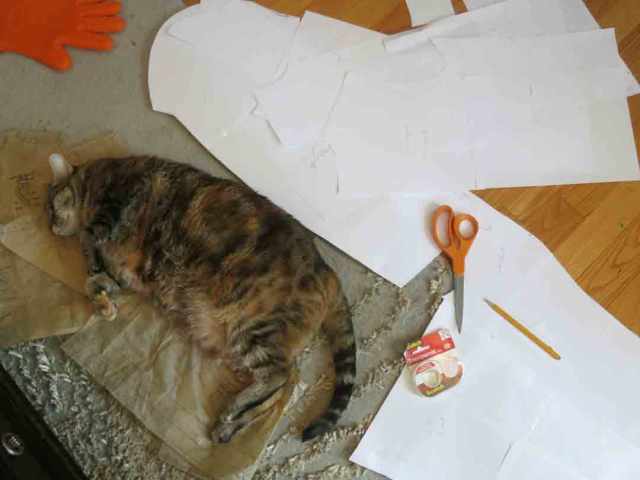
Since I’m modifying Laughing Moon 104 so extensively, I knew I would have to make a mockup, or several mockups, before finalizing the pattern. Honestly, I’d have done at least one mockup anyway, but the pattern alterations just made it even more important. (sadly, the cat decided that she was more important, which delayed things a bit)
I decided to start by using the princess-seamed front pieces of the underbodice, but the more simplified back pieces of the guimpe (separate underblouse). I figured that this would allow for easier application of the trim and reduce bulk under the bretelles in front (since I could stitch the trim across the bustline to just the center front panel and hide the raw edges in the seams), but still allow movement due to the looser fit of the back. I first cut out the pieces as-is out of an old sheet and seamed them together as instructed, but it quickly became apparent that the bustline didn’t fit properly at all. The dress doesn’t appear to have been designed to be worn over a corset, or at least not the kind of corset that I have, since the curve of the dress bodice creates a high, perky bustline that’s almost pointy in shape. It doesn’t seem to match either the slight flattening effect of my mid-Victorian corset (I know, wrong corset, but it’s all I have), or the low, full bust effect that was en vogue in the Edwardian era.
I ended up cutting the side front pieces with a shallower bust curve, figuring that the bodice itself doesn’t fit that snugly (at least, not with the loose back piece), so it wouldn’t be an issue even if I did eventually get the right Edwardian corset. Anything was better than the bullet-bra shape I was getting from the original pattern.
Once I got the shape of the bodice right I decided to make an even more significant change– moving the opening from the center back to the side front (which would be covered by the bretelles anyway). It was actually pretty easy– I just extended one side of the center front panel by about an inch so I could overlap it with the side front piece instead of stitching the seam together. I’ll add a shaped facing to the edge, then add small fasteners to keep the sides together. I converted the back to a single piece instead of two halves by omitting the seam allowances and cutting on the fold. Presto! New side opening!

I lengthened the elbow-length sleeves by about an inch, mostly because I had plans for that extra length in applying my trim and it’s easier to shorten things than to lengthen them later. Finally, I had to modify the armscye to allow for greater range of motion in the arm– I raised it at the armpit and moved it about half an inch in at the shoulder, and lengthened the sleeve at the sleeve head by the same amount. The sleeve-lengthening step was a crucial one that I’d been missing before– thanks to Jennifer Rosburgh at Historical Sewing for her immensely useful post on the subject!
I repeated the mockup process with the guimpe pattern (that’s the lacy high-necked blouse that goes underneath). My lace fabric has a little bit of stretch to it, so the pattern didn’t have to be exact– still, because I wanted the guimpe to fit closely to the arm to reduce bulk, I had to do more modification in the armscye and sleeve head. See the differences between the paper pattern and the final mockup pieces?

Worn together with some stand-in strips of fabric for the bretelles and sash, here’s what all the pieces look like (I only did one sleeve on the guimpe):

I’m not bothering to mock up the skirts, since the fit isn’t quite as important– I can always cut them larger and take up the extra fabric with pleats in the back. The underskirt will serve as a kind of trial run, since it’ll be cotton rather than satin.
Wish me luck!

So exciting- Go on, make the right corset! It makes all the difference to the way you stand after all. I love my Truly Victorian 1903 corset, it does good duty for about 10 years either side of the date, just by adjusting the padding, and it’s really comfortable too.
LikeLiked by 1 person
Looks like it’s coming together quite well!
LikeLiked by 1 person